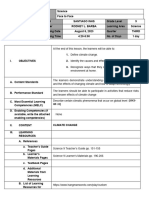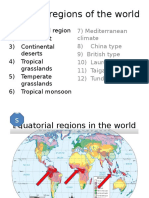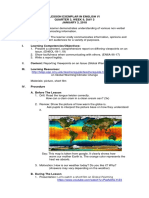Climate: Jump To Navigation Jump To Search
Climate: Jump To Navigation Jump To Search
Uploaded by
DexterCopyright:
Available Formats
Climate: Jump To Navigation Jump To Search
Climate: Jump To Navigation Jump To Search
Uploaded by
DexterOriginal Description:
Original Title
Copyright
Available Formats
Share this document
Did you find this document useful?
Is this content inappropriate?
Copyright:
Available Formats
Climate: Jump To Navigation Jump To Search
Climate: Jump To Navigation Jump To Search
Uploaded by
DexterCopyright:
Available Formats
Climate
From Wikipedia, the free encyclopedia
Jump to navigationJump to search
This page presents a general overview of Earth's climate system. For other uses of
"climate", see Climate (disambiguation)
Atmospheric sciences
Atmospheric physics
Atmospheric dynamics (category)
Atmospheric chemistry (category)
Meteorology
Weather (category) · (portal)
Tropical cyclone (category)
Climatology
Climate (category)
Climate change (category)
Global warming (category) · (portal)
Glossaries
Glossary of meteorology · Glossary of tropical cyclone terms · Glossary
of tornado terms · Glossary of climate change
v
t
e
Climate is the long-term average of weather, typically averaged over a period of 30
years.[1][2] More rigorously, it denotes the mean and variability of meteorological variables
over a time spanning from months to millions of years. [1] Some of
the meteorological variables that are commonly measured
are temperature, humidity, atmospheric pressure, wind, and precipitation. In a broader
sense, climate is the state of the components of the climate system, which includes the
ocean and ice on Earth.[1] The climate of a location is affected by its latitude, terrain,
and altitude, as well as nearby water bodies and their currents.
Climates can be classified according to the average and the typical ranges of different
variables, most commonly temperature and precipitation. The most commonly used
classification scheme was the Köppen climate classification. The Thornthwaite system,
[3]
in use since 1948, incorporates evapotranspiration along with temperature and
precipitation information and is used in studying biological diversity and how climate
change affects it. The Bergeron and Spatial Synoptic Classification systems focus on
the origin of air masses that define the climate of a region.
Paleoclimatology is the study of ancient climates. Since very few direct observations of
climate are available before the 19th century, paleoclimates are inferred from proxy
variables that include non-biotic evidence such as sediments found in lake beds and ice
cores, and biotic evidence such as tree rings and coral. Climate models are
mathematical models of past, present and future climates. Climate change may occur
over long and short timescales from a variety of factors; recent warming is discussed
in global warming. Global warming results in redistributions. For example, "a 3°C
change in mean annual temperature corresponds to a shift in isotherms of
approximately 300–400 km in latitude (in the temperate zone) or 500 m in elevation.
Therefore, species are expected to move upwards in elevation or towards the poles in
latitude in response to shifting climate zones".[4][5]
You might also like
- Social Studies Pamphlet Grade 8 & 9Document108 pagesSocial Studies Pamphlet Grade 8 & 9Adminstrator Intern95% (190)
- Barba Lesson-Exemplar Q3Document7 pagesBarba Lesson-Exemplar Q3Rodney BarbaNo ratings yet
- Introduction To ClimatologyDocument14 pagesIntroduction To ClimatologyJoseph Zotoo100% (4)
- M. I. Budyko (Auth.) - Climatic Changes-By The American Geophysical Union. (1977)Document271 pagesM. I. Budyko (Auth.) - Climatic Changes-By The American Geophysical Union. (1977)Edson Neves Jr.100% (1)
- ClimateDocument12 pagesClimatePt TiwariNo ratings yet
- ClimateDocument11 pagesClimatepetalverjun270No ratings yet
- Climatology: Jump To Navigationjump To SearchDocument2 pagesClimatology: Jump To Navigationjump To SearchDean Joyce AlborotoNo ratings yet
- Climatology: Jump To Navigationjump To SearchDocument11 pagesClimatology: Jump To Navigationjump To SearchLali HajzeriNo ratings yet
- Study On Climate ChangeDocument16 pagesStudy On Climate ChangejoelNo ratings yet
- Climate Change: Atmospheric SciencesDocument49 pagesClimate Change: Atmospheric SciencesLiza Mae NeisNo ratings yet
- no es budenoDocument9 pagesno es budenodebeligavranNo ratings yet
- ClimateDocument5 pagesClimateborisiusNo ratings yet
- Climate Change: Navigation SearchDocument13 pagesClimate Change: Navigation SearchRovina Narayan DiasNo ratings yet
- 303 Climatology: Nazmun NaharDocument76 pages303 Climatology: Nazmun NaharProf. Vandana Tiwari SrivastavaNo ratings yet
- Atmosphere, Climate and Weather: Atmospheric LayersDocument11 pagesAtmosphere, Climate and Weather: Atmospheric LayersUdayveerSinghNo ratings yet
- Climate Definition MesutDocument37 pagesClimate Definition Mesutvladotrkulja100% (2)
- Climate Is The Statistics Of: (Hide) 1 2 o 2.1 o 2.2 o 2.3 3 o 3.1 o 3.2 4 o 4.1 5 6 7 8Document9 pagesClimate Is The Statistics Of: (Hide) 1 2 o 2.1 o 2.2 o 2.3 3 o 3.1 o 3.2 4 o 4.1 5 6 7 8Monika KshetriNo ratings yet
- Climatology King R Queen PDocument214 pagesClimatology King R Queen PAsif aliNo ratings yet
- ClimateDocument1 pageClimateSrishti KumariNo ratings yet
- ClimateDocument8 pagesClimatedilhanthausjpNo ratings yet
- Meteorology: WeatherDocument12 pagesMeteorology: WeatherJeanMVillaverdeNo ratings yet
- ClimateDocument7 pagesClimateMuhammad AminNo ratings yet
- What Is ClimateDocument3 pagesWhat Is ClimateJedha YantiNo ratings yet
- ClimatologyDocument26 pagesClimatologydjoatessNo ratings yet
- Climate VariabilityDocument3 pagesClimate Variabilityaruba anwarNo ratings yet
- GS503: Climate Change:: Welcome ToDocument44 pagesGS503: Climate Change:: Welcome Tomd shohagul islamNo ratings yet
- Climate-Worksheets-SampleDocument14 pagesClimate-Worksheets-Samplera monaNo ratings yet
- Nature and Scope of ClimatologyDocument2 pagesNature and Scope of ClimatologyNova Chrono100% (1)
- Overview of Climate ScienceDocument19 pagesOverview of Climate ScienceDefry HastriaNo ratings yet
- 1 Earth System - Intro - To - BiosphereDocument74 pages1 Earth System - Intro - To - BiosphereC LMNo ratings yet
- Esm 212 Tropical Climatology - UneditedDocument163 pagesEsm 212 Tropical Climatology - UneditedBrian CopperNo ratings yet
- Env 2Document3 pagesEnv 2ankitabhat93No ratings yet
- Lecture 02 - Atmosphere and WeatherDocument12 pagesLecture 02 - Atmosphere and WeatherTheresa TomalesNo ratings yet
- Climate ZonesDocument7 pagesClimate ZonesJhemhicis BielzaNo ratings yet
- Gpy 203Document12 pagesGpy 203Saheed Remilekun AjibolaNo ratings yet
- Climate ChangeDocument17 pagesClimate ChangeAbiyyu Muhammad HarisNo ratings yet
- Climatology Part 1Document18 pagesClimatology Part 1amanamu436No ratings yet
- Human and Societal Dimensions of Past Climate ChangeDocument43 pagesHuman and Societal Dimensions of Past Climate ChangeVictoria RamenzoniNo ratings yet
- All Notes Climatology_081704Document112 pagesAll Notes Climatology_081704nefer1336No ratings yet
- Climatology and World WeatherDocument30 pagesClimatology and World Weathermahadi972002No ratings yet
- climateDocument4 pagesclimatescm28No ratings yet
- Meteorology by Coleman and LawDocument7 pagesMeteorology by Coleman and LawAliah MosqueraNo ratings yet
- 01 Introduction Climate SystemDocument34 pages01 Introduction Climate SystemzhangyuluNo ratings yet
- Air Climate, Weather and BiodiversityDocument4 pagesAir Climate, Weather and BiodiversityAnne Isabel BalolongNo ratings yet
- L -1Document22 pagesL -1Raiyan Zaman AdreyNo ratings yet
- Nature and Scope of ClimatologyDocument7 pagesNature and Scope of Climatologymstluangapachuau19No ratings yet
- C - Lecture 01Document31 pagesC - Lecture 01masrur.quaderNo ratings yet
- Climate Change and Energy CrisisDocument11 pagesClimate Change and Energy CrisisAsher GeronimoNo ratings yet
- ClimatologyDocument89 pagesClimatologysherincbabychempariyilNo ratings yet
- Agro ClimatologyDocument125 pagesAgro Climatologyasnakeketema12No ratings yet
- CLIMATOLOGYDocument11 pagesCLIMATOLOGYGenaro Tibig Jr.No ratings yet
- Weather and ClimateDocument30 pagesWeather and ClimateDaniella BicoNo ratings yet
- Climate Models - 2023 - 24 - L1Document33 pagesClimate Models - 2023 - 24 - L1meteo15156No ratings yet
- Reviewer For HydrologyDocument77 pagesReviewer For HydrologyIan Karl BabieraNo ratings yet
- Lecture Notes On Climatology: Integrated Meteorological Training CourseDocument90 pagesLecture Notes On Climatology: Integrated Meteorological Training CourseDasSonam100% (1)
- 3. Climate (1)Document39 pages3. Climate (1)Rime BouNo ratings yet
- Chapter 3a (1)Document30 pagesChapter 3a (1)Sara Shahrin Moumi20223No ratings yet
- Thermosphere: Jump To Navigationjump To SearchDocument5 pagesThermosphere: Jump To Navigationjump To SearchjayalaxmiNo ratings yet
- EHS 701 - Climate Change and Society Lecture (First Semester 2023-2024 Session) Oct 2024Document68 pagesEHS 701 - Climate Change and Society Lecture (First Semester 2023-2024 Session) Oct 2024oodeyemi246099No ratings yet
- Climatology PDFDocument3 pagesClimatology PDFAYELE YISEHAKNo ratings yet
- Agricultural MeterologyDocument63 pagesAgricultural Meterologymohan100% (4)
- Paleoclimates: Understanding Climate Change Past and PresentFrom EverandPaleoclimates: Understanding Climate Change Past and PresentRating: 4 out of 5 stars4/5 (1)
- Verb (1) : Synonyms & Antonyms of Wax (Entry 1 of 2)Document7 pagesVerb (1) : Synonyms & Antonyms of Wax (Entry 1 of 2)DexterNo ratings yet
- BottleDocument3 pagesBottleDexterNo ratings yet
- Glass: Definition of Glass (Entry 2 of 4)Document2 pagesGlass: Definition of Glass (Entry 2 of 4)DexterNo ratings yet
- Synonyms & Antonyms of Mop: Save Word To Save This Word, You'll Need To Log inDocument6 pagesSynonyms & Antonyms of Mop: Save Word To Save This Word, You'll Need To Log inDexterNo ratings yet
- PlanetDocument1 pagePlanetDexterNo ratings yet
- List of Tectonic Plates: Jump To Navigation Jump To SearchDocument2 pagesList of Tectonic Plates: Jump To Navigation Jump To SearchDexterNo ratings yet
- Earth's Crust: Jump To Navigation Jump To SearchDocument2 pagesEarth's Crust: Jump To Navigation Jump To SearchDexterNo ratings yet
- Definition of Shoe (Entry 1 of 2) : Log inDocument2 pagesDefinition of Shoe (Entry 1 of 2) : Log inDexterNo ratings yet
- Glass: Noun, Often AttributiveDocument1 pageGlass: Noun, Often AttributiveDexterNo ratings yet
- Matter Mass (Liturgy) Mass (Disambiguation) : Jump To Navigationjump To SearchDocument4 pagesMatter Mass (Liturgy) Mass (Disambiguation) : Jump To Navigationjump To SearchDexterNo ratings yet
- General RelativityDocument4 pagesGeneral RelativityDexterNo ratings yet
- Mathematics: Jump To Navigation Jump To SearchDocument6 pagesMathematics: Jump To Navigation Jump To SearchDexterNo ratings yet
- Quantum: Etymology and DiscoveryDocument3 pagesQuantum: Etymology and DiscoveryDexterNo ratings yet
- Multi-Channel Memory Architecture: Jump To Navigation Jump To SearchDocument3 pagesMulti-Channel Memory Architecture: Jump To Navigation Jump To SearchDexterNo ratings yet
- Inertia: Jump To Navigation Jump To SearchDocument5 pagesInertia: Jump To Navigation Jump To SearchDexterNo ratings yet
- DDR Sdram: and TypesDocument13 pagesDDR Sdram: and TypesDexterNo ratings yet
- Data Buffer: ApplicationsDocument2 pagesData Buffer: ApplicationsDexterNo ratings yet
- Backplane: Jump To Navigationjump To SearchDocument4 pagesBackplane: Jump To Navigationjump To SearchDexterNo ratings yet
- Observable Universe: Jump To Navigationjump To SearchDocument6 pagesObservable Universe: Jump To Navigationjump To SearchDexterNo ratings yet
- Calculator: Jump To Navigation Jump To SearchDocument12 pagesCalculator: Jump To Navigation Jump To SearchDexterNo ratings yet
- Ancient Egyptian Royal CubitDocument2 pagesAncient Egyptian Royal CubitDexterNo ratings yet
- Orbital Period: AstrodynamicsDocument5 pagesOrbital Period: AstrodynamicsDexterNo ratings yet
- Climate Responsive Design - Bungalow+OfficeDocument10 pagesClimate Responsive Design - Bungalow+OfficeNikita SahujiNo ratings yet
- National PrideDocument13 pagesNational Priderosana f.rodriguezNo ratings yet
- Aosc200 202405 0 110989646Document8 pagesAosc200 202405 0 110989646KingsManNo ratings yet
- Geography: Rashtrasant Tukadoji Maharaj Nagpur University NagpurDocument19 pagesGeography: Rashtrasant Tukadoji Maharaj Nagpur University NagpurEfuck100% (1)
- Case Study of Global WarmingDocument10 pagesCase Study of Global Warming04-SYCO- Manali Ghule.No ratings yet
- Science 9 Q3 Week 7Document10 pagesScience 9 Q3 Week 7Alfred Villego SantiagoNo ratings yet
- Activity On Earth and Environmental Sciences Willard UyDocument3 pagesActivity On Earth and Environmental Sciences Willard UyKarl Chan UyNo ratings yet
- Model E Unit 2 Lesson 3 Exploration 3Document18 pagesModel E Unit 2 Lesson 3 Exploration 3Kayla JohnsonNo ratings yet
- Gwenthia 002.2 2006Document103 pagesGwenthia 002.2 2006lolo1972No ratings yet
- Activity#3 Group#1 Abe33Document13 pagesActivity#3 Group#1 Abe33Lowela Zyrah Monreal100% (1)
- YuriNoemiSadoyama ENVENG795BDocument46 pagesYuriNoemiSadoyama ENVENG795BYuri Noemi SadoyamaNo ratings yet
- Graded Homework PDFDocument4 pagesGraded Homework PDFMariam KhosiashviliNo ratings yet
- Brunei ClimateDocument10 pagesBrunei ClimateAimi AdamNo ratings yet
- Climate of India Class 10 ICSEDocument14 pagesClimate of India Class 10 ICSEshreyammandal001No ratings yet
- Lesson Plan (Climatology s3)Document2 pagesLesson Plan (Climatology s3)Dipu George100% (2)
- Geo 7Document71 pagesGeo 7Raaja Shekhar100% (1)
- Global warming.-WPS OfficeDocument18 pagesGlobal warming.-WPS OfficeAkshata KadamNo ratings yet
- Lesson Exemplar in English Vi, Jan. 3, 3018Document4 pagesLesson Exemplar in English Vi, Jan. 3, 3018Vicmyla Mae A. CabonelasNo ratings yet
- LondonDocument8 pagesLondonrita machadoNo ratings yet
- Spatially Heterogeneous Habitat Use Across DistincDocument18 pagesSpatially Heterogeneous Habitat Use Across DistincMIhai MiuNo ratings yet
- Structure of The Geography Paper of The New Lower Competence Based CurricurumDocument3 pagesStructure of The Geography Paper of The New Lower Competence Based CurricurumbyansiyahayaNo ratings yet
- Expected Geography MCQs PT 2020 MYUPSCDocument40 pagesExpected Geography MCQs PT 2020 MYUPSCjayshri bamneNo ratings yet
- Biomes Information PacketDocument5 pagesBiomes Information Packetapi-305092096100% (1)
- 3331 Lecture6 GlobalCirculation F13Document30 pages3331 Lecture6 GlobalCirculation F13Trevor ChadNo ratings yet
- Chapt 6 Mauritius Wind Speed PDFDocument65 pagesChapt 6 Mauritius Wind Speed PDFDeepum HalloomanNo ratings yet
- CNCMP Informational Kit WEBDocument11 pagesCNCMP Informational Kit WEBRainbow Construction LtdNo ratings yet
- Is The Earth Getting WarmerDocument9 pagesIs The Earth Getting Warmersalmanq_1850% (2)















































































































